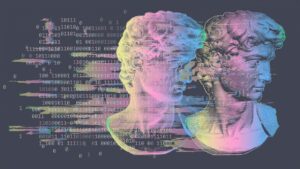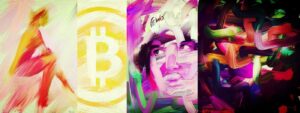Watching movies and TV, you’d have to assume there are only two ways to own really expensive and rare art:
1) being a stacked billionaire drinking champagne on a yacht while henchmen flash a bid paddle for you at an auction, or
2) you look good in a black turtleneck and can rappel from the ceiling, avoiding those laser motion detectors that obviously protect all art from thieves like you.
Let’s face it, those two options feel like a lost cause for most of us.
But wouldn’t it be cool to own some famous, rare, original works or art? And wouldn’t it be even cooler to get a return on that investment?
In the last few decades, contemporary artist investments have outperformed the S&P at 14% returns compared to 9.5%, but the industry remains extremely old-school with a lot of difficult problems that stop highly modern investors and average retail investors from buying in. Fine art tokenization has its sights on bringing the antiquated art world into the 21st century and opening access to investors like you and me.
Let’s talk about what that would actually look like.
Legacy challenges in the old-school art industry
Ok, so the movie version of the fine art world may not be perfectly accurate. But there are some aspects of the industry that seem almost that ridiculous in our globalized, technological society.
For example, art acquisition does tend to be an in-person auction process. This is geographically restrictive, especially in a post-COVID world where travel and in-person events are more difficult. In fact, the global art market has dropped by about $14 billion since the start of COVID. But that’s just an in-the-last-year kind of problem. There are bigger, more perennial difficulties plaguing the art world that tokenization could fix.

Transparency
Because art does not have an easily determined quality or value, that makes pricing art quite an obscure process. This lack of price transparency has been around since art has been bought and sold. If you don’t have expertise and education in what gives art symbolic value culturally, historically, visually, or technically, you will be forced to trust those who have or claim to have that knowledge.
Copyright and provenance
The age of the internet brought copyright concerns to the forefront of public consciousness because of how easily digital information like photos and videos are copied and shared. But even a physical painting can be forged; buying prints is not the same as original paintings, and so on. The question of provenance—record of origin and ownership—is incredibly difficult with art when you’re in danger of buying a forgery, or a stolen piece.
Expensive and slow
It is true that most art investors are high net worth individuals who have the capital to invest in expensive, cultural commodities. Some people buy art for aesthetic and emotional reasons but when bananas taped to the wall are going for $120,000, you better have deep pockets to invest on aesthetics. Not to mention, buying physical art is slow and tedious, like any investment involving trust. There’s paperwork for verification, appraisals, ownership transfer, then there’s insurance and shipping, which may be 3-7% of the price of the piece. Not to mention storing and maintaining it properly—I hope you have a pair of white gloves, soft lighting, and climate control.
High fees and low liquidity
In addition to the insurance and shipping and storing fees, there are dealer fees, appraisal fees, and other fees—like the salary you have to pay the cronies who go to the auction for you while you do rich people stuff. Plus, once you actually get that priceless art piece in your collection, it’s an extremely illiquid asset. If you need capital fast, your fine art isn’t the first place to go to pull out cash.
New tokenization solutions explained
Clearly there are plenty of hurdles to entering the fine art market. But as crypto enthusiasts, we have high hopes for improvements that can allow peer-to-peer art trading, easier retail investor entry, more transparency, more security, and liquidity. Really, what doesn’t blockchain and tokenization solve?
 Blockchain
Blockchain
The problem of provenance for fine art is definitely a job for blockchain. Especially because Bitcoin was created to solve a similar problem for digital currency. Timestamping and distributed networks allow origin to be proven. It also allows any transfer to be permanently and transparently recorded without needing a trusted third party to verify. Using blockchain technology to keep records can give artists full control over their creative work and also give investors and collectors confidence in the authenticity and originality of what they buy.
Tokenization
Part of the transparency process is tokenizing [link to tokenization article] art. If a Picasso, for example, is minted as an NFT (non-fungible token), smart contracts can be used to verify authenticity, ownership, transfers, and even current value with the help of oracles, which provide off-chain information to the network. This can be true for existing art like famous historical paintings. But it’s also helpful for contemporary artists who can tokenize art from its first creation. Artists (who don’t currently have royalty rights in the US) could also use smart contracts to earn royalties on their art every time it’s bought on the secondary market.
Once a piece of art is represented on the blockchain as non-fungible tokens, it makes peer-to-peer art trading much easier also. Logistically, a simple wallet transfer can send NFTs from one person to another, without all the intermediaries necessary in a traditional art transaction. Of course, if you want to buy 100% ownership of a piece of art, you could still take possession of it, but as interest in art investing grows, tokenized trading eliminates a lot of the old problems of location, trust, fees, and speed.
Fractional ownership
Another benefit of non-fungible tokens is fractional ownership. By dividing the value of a painting into multiple tokens, collective ownership can decrease the cost of investing. Let’s say you want to own a piece of a painting that’s worth $1 million and has been tokenized into 1,000 tokens. You could buy one for $1,000 and have 0.1% ownership. This makes art investing much more accessible to the average investor. Fractional ownership makes assets more liquid as well. Let’s say you have complete ownership of an art piece that’s been tokenized. If you wanted to get some cash out of your asset without completely liquidating it, you could sell some of your tokens but maintain as many as you wanted.
Decentralized fine art exchanges can also eliminate intermediaries like dealers who take a cut and decrease price transparency. It can also combat the black market by making legitimate trading easier and faster. Artists can list their art and sell it directly to investors, too. This kind of peer-to-peer art trading has not existed in the fine art world, and fractional ownership could create arbitrage opportunities that benefit both the artist and art traders.
Tokenization is already upon us
Bringing the slow-moving, old-school art world into the digital age is no small feat. There are definitely more technical and legal kinks to iron out as well as mindset changes in the existing industry. But the pioneers are already on the path to changing how art investing is done.
 In 2018, an art tokenization platform called Maecenas minted Andy Warhol’s “14 Small Electric Chairs.” With the help of NFTs, the painting’s valuation went from $1.7 million to $5.6 million as fractional ownership and novelty piqued people’s interest. And there are more real-world examples. A Swiss bank actually did tokenize a Picasso, becoming the first bank to offer fractional ownership of fine art. Galleries are also beginning to combine physical exhibits with NFTs to attract new investors.
In 2018, an art tokenization platform called Maecenas minted Andy Warhol’s “14 Small Electric Chairs.” With the help of NFTs, the painting’s valuation went from $1.7 million to $5.6 million as fractional ownership and novelty piqued people’s interest. And there are more real-world examples. A Swiss bank actually did tokenize a Picasso, becoming the first bank to offer fractional ownership of fine art. Galleries are also beginning to combine physical exhibits with NFTs to attract new investors.
The Saint Petersburg-based State Hermitage Museum also created limited NFT copies of Da Vinci and Van Gogh paintings. And artists like Ed Smith are beginning to tokenize their art as well. Investment funds and art DEXs that will make it possible to deliver peer-to-peer art trading are emerging and new projects are started every day.
What's next for tokenization of the fine arts industry?
Fine art is a historic industry with a lot of value and investment potential that has previously been inaccessible to most people and complicated for those who have the capital to invest.
Combining one of the oldest assets with some of the newest technology is attractive to both traditional and culturally minded investors as well as young, tech-savvy speculative investors. So many of the problems that have plagued art investing can be smoothed with non-fungible tokens and peer-to-peer art trading.
Are you excited for what the future holds?
About the Author

Emily Weber
About Decentral Publishing
Decentral Publishing is dedicated to producing content through our blog, eBooks, and docu-series to help our readers deepen their knowledge of cryptocurrency and related topics. Do you have a fresh perspective or any other topics worth discussing? Keep the conversation going with us online at: Facebook, Twitter, Instagram, and LinkedIn.


